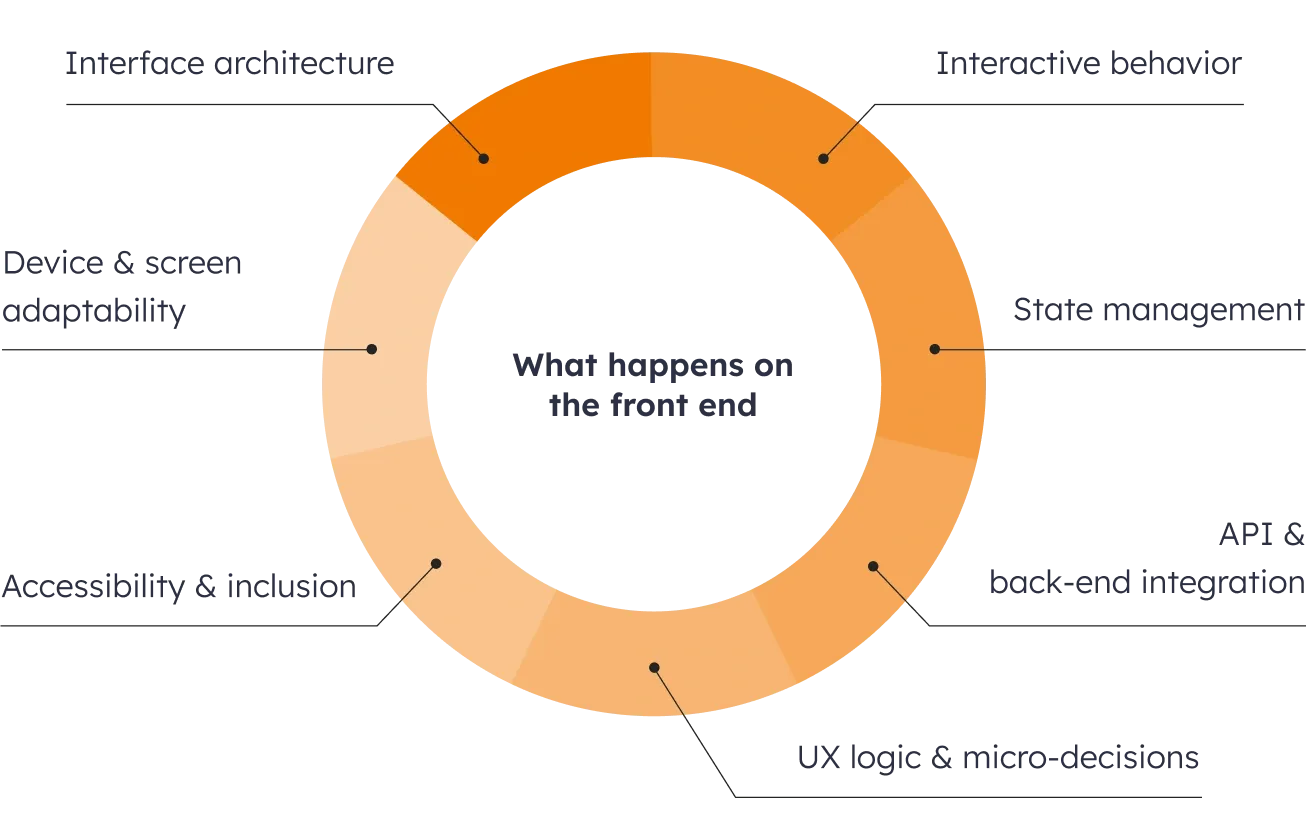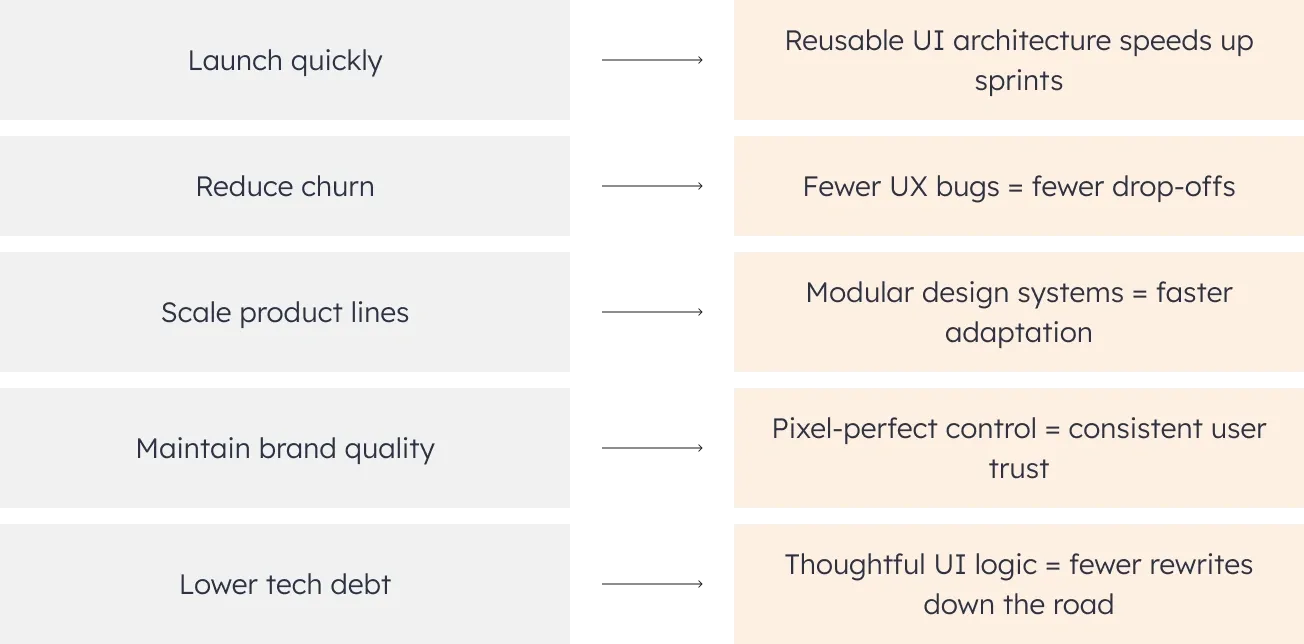
What is front-end software development – for builders and decision-makers

Dmitry Panin
Head of JavaScript Department
You open an app. Or land on a website. You’re in a rush – maybe looking for a product, booking a service, joining a webinar. Should take 30 seconds max. But suddenly… it doesn’t.
The menu feels off. You scroll twice to find what should’ve been obvious. A button moves. A form resets. Two clicks become eight. Frustration builds – and with it, your trust fades.
You close the tab. You delete the app. And just like that, the product – the company – is gone from your world.
This is what front-end development does. Or more accurately, this is what bad front-end development does.
I’m Dmitry Panin, Head of JavaScript at Modsen – with a few hundred JS engineers behind me. My job is to make sure that doesn’t happen – not to our users, not to our clients, not to their customers.
In this article, I’ll break down front-end definition for you:
What it is – beyond the obvious,
What it includes – across platforms,
Why it matters – not just to developers, but to businesses.
If you’ve ever been curious about any of these questions – here is the one guide you need. Let’s get into it.
How far does the definition of front end actually go?
So, what does front end mean in the context of modern software? It’s the part users see, interact with, and rely on to navigate the product – the visible layer where logic, design, and experience converge.
That’s the short answer – and it’s technically correct. But if you’re here just for the definition, you’re missing the deeper story.
Because front end isn’t just about making things “look good.” It’s where design decisions meet code, where logic becomes user experience, and where users form interest – or lose it – in seconds.
And yes – all of this work has a name. What’s a front-end developer? We’ve got a separate deep dive – right here.
Yet, for all its importance, the meaning of front end is often reduced to visuals. But as we’ll see further, this surface layer hides some of the most complex, high-stakes decisions in modern development and business.
Behind the UI: What does front-end development include?
In reality, front-end development today covers a surprisingly wide scope of responsibilities – from how fast and smoothly the interface works to making sure it runs well on any device – and even how users feel when using it.

From visuals to behavior – the invisible logic behind every user's interaction
Let’s take a closer look at what these aspects mean in practice – and how they help define front end today.
Interface architecture
Designing how the application is structured visually and logically. It’s not just “putting elements on a page” – it’s planning how people move, act, and find meaning inside the product.
Interactive behavior
Dropdowns, sliders, animations, transitions, form validation, keyboard controls – all of this falls under front-end logic. It’s what makes a UI feel alive, not static.
Device & screen adaptability
A user might switch from a desktop to a phone, from iOS to Android, or from dark mode to light mode – and expect the same clarity and speed. Front-end development includes making that seamless.
State management
How do we show “loading,” “error,” or “saved”? What happens when a user toggles settings? Front-end part handles the real-time reflection of user actions and data changes.
Accessibility & inclusion
What is considered front-end development today includes designing for users with disabilities: screen reader support, keyboard navigation, high-contrast modes – all built into the UI layer.
Integration with APIs & back-end data
Every dynamic interface is connected to something: databases, services, logic layers. A front-end developer bridges the user interaction with the application’s brain.
UX logic & micro-decisions
What happens when you click that button? What’s the best place for that label? How fast should a tooltip fade? This is what front end means when done right – constant, careful decisions that shape how users feel about a product.
“Front-end work includes dozens of micro-decisions that no user sees directly – but every user feels.”
And while the line between design, product, and development can blur, it’s front-end engineers who bring all three together on screen.
Inside front-end development: programming and engineering layers
So, it's clear now that the client side of any app may start with visuals – but it quickly becomes something else entirely: a system of logic, behavior, architecture, and performance that controls how users experience the product.
Let’s break it down – from the code that runs in your browser to the systems that keep your product from falling apart at scale.
From interface to logic – front-end programming
The programming layer of the front end begins where static design ends. It’s what makes interfaces dynamic, responsive, and context-aware. In simpler terms – this is where actual coding starts.
At first glance, it may seem straightforward. Just connect some data, build a few components, throw in a button or two. But here’s the catch: the front-end meaning in programming isn’t just about writing code – it’s about writing behavior.
Even the most naturally gifted devs – and I’ve met many during our internships – quickly learn that. Because shaping logic that users actually trust and enjoy takes more than syntax. It takes intent.
If you’re curious what it takes to build these kinds of experiences from the ground up – check out my breakdown of front-end developer skills for freshers.
Here’s what that layer handles in practice.
What is front-end programming today
Focus area | What it involves |
|---|---|
State logic & data flow | Designing data flow, syncing UI with app state – core front-end logic in dynamic products – managing local/global/store-based states. |
Event orchestration | Managing what happens when users click, scroll, swipe – especially under pressure or in weird orders. |
Async & fallback flows | Handling delays, failures, retries, and loading states cleanly in the interface. |
Conditional rendering | Dynamically showing, hiding, or restructuring elements based on real-time context or data. |
UI feedback control | Delivering the right feedback – loaders, confirmations, errors, placeholders – patterns that help define front-end clarity. |
Cross-platform UX logic | Making sure the UI behaves intuitively on mobile, desktop, across OS, screen sizes, and input types. |
Performance optimization | Speeding up interactions: smart rendering, lazy loading, hydration strategies. |
None of this is “extra.” This is the logic that makes an interface function – not just appear. But code alone doesn’t build sustainable products. My front-end team never stops at implementation – we design systems that perform under pressure, scale with demand, and evolve with the product.
That’s the difference between programming and engineering. And it’s what we’ll look at next.
From logic to longevity – front-end engineering
Again – this isn’t where you start. It’s where you arrive – after mastering how systems behave, break, and grow. Not just writing UI logic – but building a resilient, performant, and extensible foundation behind it.
How front-end engineering transforms code into product value
What users see | Engineering output | Business value |
|---|---|---|
A button appears | State is initialized, action is debounced, fallback logic is ready | No duplicate actions, no broken flows → fewer bugs, less support, smoother UX |
A form validates | Rules are abstracted, edge cases handled, error UX is consistent | Fewer failed submissions → higher conversion rate, better data quality |
Data loads instantly | Caching, throttling, and async flows are optimized and fault-tolerant | Fast UX → increased engagement, better retention, lower bounce rate |
Mobile layout adapts | Responsive systems, media queries, and layout constraints work across breakpoints | Broader reach across devices → more users, lower redesign cost |
UI stays consistent | Design system tokens, theming logic, and component contracts are enforced across the front-end layer | Brand perception stays strong → higher trust, less confusion, faster onboarding |
It “just works” everywhere | SSR, hydration, bundling, versioning, accessibility, browser compatibility, testing pipelines | Fewer production issues → lower QA cost, higher release confidence, improved SEO |
In short: front-end engineering turns code into a long-term product asset. It’s what ensures that what looks great today still works tomorrow – at scale, under pressure, and across platforms.
Yes – it’s software engineering. But not hidden deep in the stack. It lives at the edge – where every technical decision becomes a user experience. And where user experience becomes business impact. And that means it’s time to unpack...
Front-end meaning in business
Click. Load. Convert. Or not. And that’s not a coincidence.
Because a good front end is where your strategy becomes visible. Where your roadmap becomes usable. Where your product meets the market – and users decide whether to try it or leave it behind.
“If your front end can’t communicate your product’s value clearly, your users won’t see it at all. And if they can’t see it, they won’t come back.”
Think of every business objective – launching faster, reducing churn, scaling across markets, preserving brand consistency. In all of these cases, it’s the quality of front-end development that determines whether those goals are actually achievable – or constantly delayed by rework, bugs, or UX debt.
Strong front-end systems support growth. They reduce the cost of change. They speed up delivery and help teams scale without stepping on each other’s toes. And more than anything – they protect the user’s trust, which is one of the most fragile business assets in digital products.
On the other hand, a weak or improvised front end often leads to the opposite: delays, regressions, misalignment between design and implementation, and growing gaps between what the business wants to do – and what the product can handle.
Front-end development as a business driver

This is what happens when your front-end team speaks business as well as code
Final thoughts about front-end
Front-end development may start with layout and style – but it quickly becomes something deeper: a system where logic, design, and business goals meet.
Whether you're building your first product or your fifth, whether you’re writing your first lines of code or leading a digital transformation – understanding what front end really means can help you build smarter, faster, and with greater confidence.
And if you ever feel stuck – technically, strategically, or conceptually – feel free to reach out. We work on front-ends that aren’t just functional, but truly product-ready – and we’re always eager to help.
Thanks for reading. Hope this helped clarify more than just definitions.

Get a weekly dose of first-hand tech insights delivered directly to your inbox